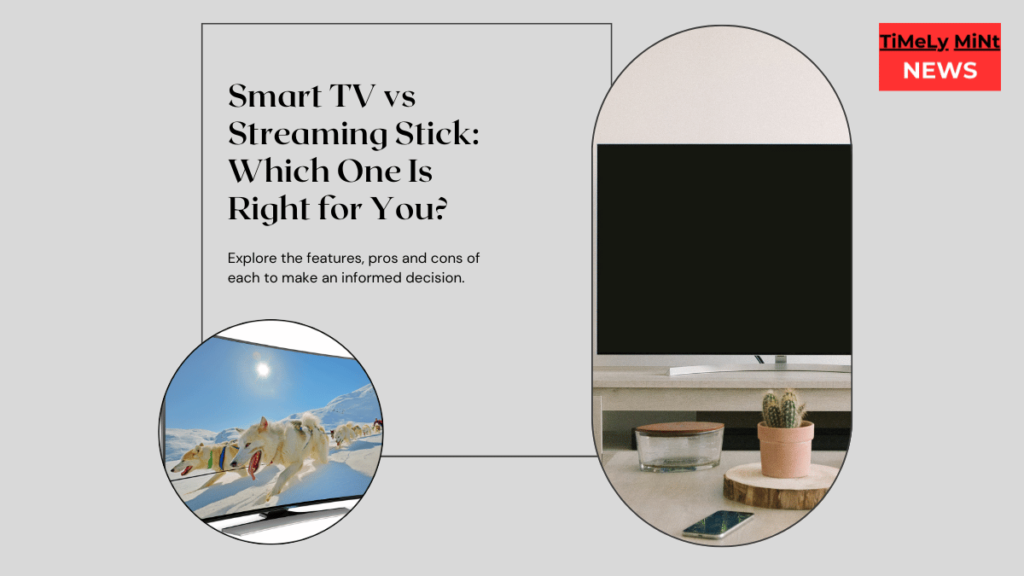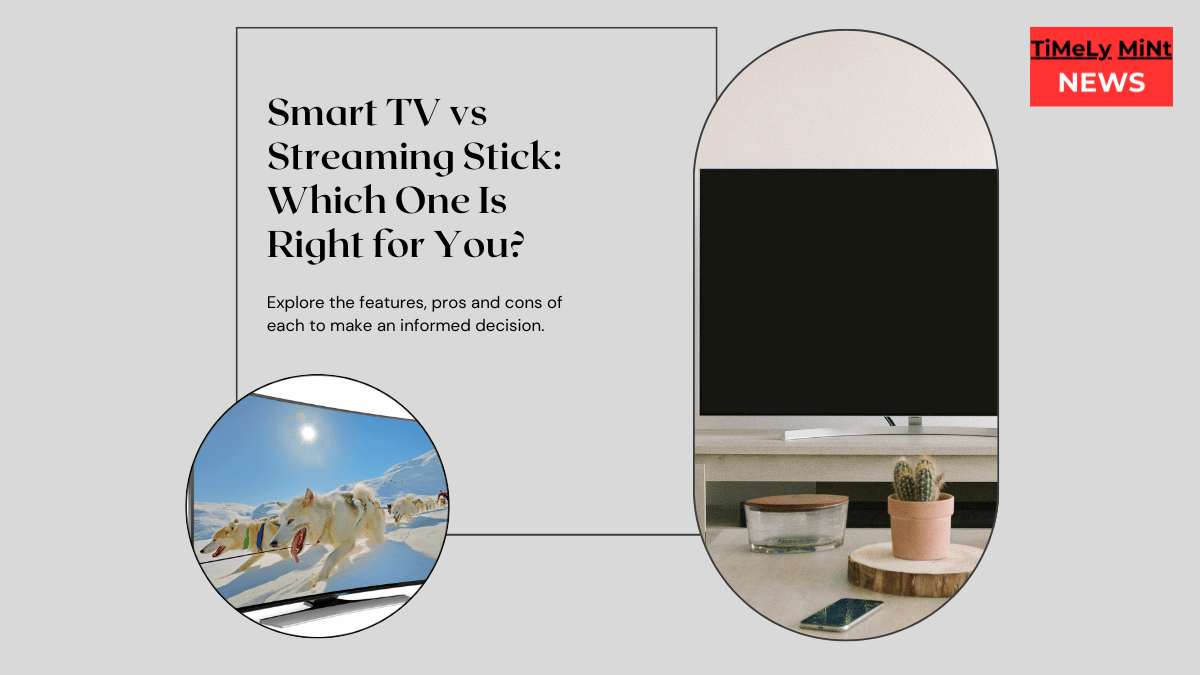Whenever you feel like upgrading your home viewing experience theres one question that always lingers for many days before making a decision, Smart TV vs Streaming Stick, which is worth the buck? The evolution of home entertainment has been nothing short of revolutionary. With the advent of Smart TVs and Streaming Sticks, the debate around which is the better investment has become increasingly relevant. In this comprehensive blog post, we’ll delve deep into the Pros and Cons of each, offering insight to help you make an informed decision tailored to your lifestyle and entertainment needs.
Introduction
The web of home entertainment has expanded significantly in the last decade. As we stand at the crossroads of technology and convenience, understanding the nuances of Smart TVs and Streaming Sticks has never been more crucial. These devices not only redefine our viewing experience but also come with their own set of advantages and drawbacks.
Understanding Smart TVs
Definition and Key Features
A Smart TV, in essence, is a television set with integrated internet and interactive “Web 2.0” features. It allows users to stream music and videos, browse the internet, and view photos. With built-in apps such as Netflix, Hulu, and Amazon Prime, a Smart TV is a powerhouse of digital entertainment.
Pros of Choosing a Smart TV
- Convenience of Built-in Features: Everything you need for a night of entertainment is housed within one sleek device.
- Range of Sizes and Quality Options: Whether you’re looking for a compact 32-inch for your bedroom or a massive 75-inch 4K Ultra HD TV for the living room, Smart TVs offer a wide selection.
- Integration with Smart Home Ecosystems: Many Smart TVs seamlessly integrate with Amazon Alexa or Google Assistant, making it easier to control your home’s tech ecosystem.
Cons of Smart TVs
- Higher Cost Compared to Streaming Sticks: The advanced technology and features of Smart TVs come at a premium.
- Possible Obsolescence of Built-in Technology: The rapid pace of technological advancements can render a Smart TV’s technology obsolete.
- Limited Upgradeability: Unlike Streaming Sticks, you cannot simply upgrade the OS or apps without considering a new purchase.
Exploring Streaming Sticks
What Are Streaming Sticks?
A Streaming Stick is a compact device that plugs into a TV’s HDMI port, providing access to a wide range of streaming services and apps. Devices like the Amazon Fire Stick, Roku Streaming Stick, and Google Chromecast are popular options that transform any ordinary TV into a Smart TV.
Advantages of Streaming Sticks
- Cost-effectiveness: Streaming Sticks offer an economical entry point into the world of digital entertainment.
- Portability and Ease of Use: Their small size makes it easy to move between TVs or take on-the-go.
- Flexibility in App Choice and Upgradeability: Users can easily add or remove apps and regularly receive software updates.
Disadvantages of Streaming Sticks
- Requirement of an Existing HDMI-supporting TV: Without an HDMI port, a Streaming Stick is redundant.
- Potential Compatibility Issues with Older TVs: Not all functionalities may be supported.
- Dependence on External Power Source: Many require a separate power supply, which can clutter your setup.

Technical Considerations
Performance and Quality
While both Smart TVs and Streaming Sticks offer up to 4K resolution, the built-in streaming capability of Smart TVs might provide a slight edge in reducing lag and buffering issues, thanks to their typically stronger processing power.
Connectivity Options
Most Smart TVs and Streaming Sticks now support both WiFi and Ethernet connections. However, an Ethernet connection can offer a more reliable streaming experience, especially for high-definition content.
User Interface and Experience
This is highly subjective and varies significantly between brands and models. Generally, Streaming Sticks receive more frequent updates, which might provide a smoother user experience over time compared to some Smart TVs.
Financial Implications
Initial Costs and Long-term Investments
When considering the initial investment, Streaming Sticks are undeniably more affordable. However, considering longevity and future-proofing, the debate gets more nuanced. Smart TVs, while more expensive upfront, could offer a better long-term value due to their integrated features and larger screen sizes.
Subscription Services and Additional Expenses
Both options require subscriptions to access most content, which can add up. Additionally, Smart TVs might incur higher energy costs due to their larger screens and built-in features.
Energy Consumption and Efficiency
Streaming Sticks consume significantly less power compared to Smart TVs, making them a more environmentally friendly and cost-efficient option in terms of energy use.
Making the Decision
Lifestyle and Usage Patterns
Your choice should align with your lifestyle and how you consume media. For avid tech enthusiasts and those who prioritize cutting-edge technology and quality, a Smart TV might be the preferred choice. Conversely, those seeking flexibility, portability, and cost efficiency might find a Streaming Stick more appealing.
Room and Setup Considerations
The size of your room and the setup you envision play crucial roles. A larger living room might benefit more from a Smart TV’s larger screen and superior audio capabilities, while a bedroom or a small apartment might be better suited for the simplicity and compactness of a Streaming Stick.
Future-proofing Your Entertainment
In an era where technology swiftly changes, considering how each option adapts to future advancements is critical. Streaming Sticks, due to their affordability and upgradability, might offer a more flexible approach to keeping up with the latest technology trends.
Conclusion
Both Smart TVs and Streaming Sticks have carved significant niches. The decision between the two boils down to personal preference, lifestyle, and specific entertainment needs. Assessing both options’ advantages and disadvantages in line with your priorities will guide you to make an informed investment, ensuring countless hours of high-quality entertainment tailored just for you.
FAQs
- Can I use a Streaming Stick with any TV? Yes, as long as the TV has an HDMI port.
- Do Smart TVs require internet to use all their features? Most features, yes, particularly streaming and online services.
- How often should I replace my Smart TV or Streaming Stick? This depends on your desire to keep up with technological advancements. Generally, a Smart TV could last 5-7 years, while Streaming Sticks might be replaced more frequently to keep up with newer models.
- Are there any hidden costs associated with Smart TVs or Streaming Sticks? Aside from subscription services, Smart TVs might incur higher energy bills, and Streaming Sticks may need additional accessories like an HDMI extender or an Ethernet adapter for better connectivity.
- Can a Streaming Stick make my old TV a Smart TV? Absolutely. As long as your TV has an HDMI port, a Streaming Stick can provide access to streaming apps and services, essentially converting it into a Smart TV.













